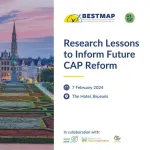(Press-News.org) WEST LAFAYETTE, Ind. — Cooking on your gas stove can emit more nano-sized particles into the air than vehicles that run on gas or diesel, possibly increasing your risk of developing asthma or other respiratory illnesses, a new Purdue University study has found.
“Combustion remains a source of air pollution across the world, both indoors and outdoors. We found that cooking on your gas stove produces large amounts of small nanoparticles that get into your respiratory system and deposit efficiently,” said Brandon Boor, an associate professor in Purdue’s Lyles School of Civil Engineering, who led this research.
Based on these findings, the researchers would encourage turning on a kitchen exhaust fan while cooking on a gas stove.
The study, published in the journal PNAS Nexus, focused on tiny airborne nanoparticles that are only 1-3 nanometers in diameter, which is just the right size for reaching certain parts of the respiratory system and spreading to other organs.
Recent studies have found that children who live in homes with gas stoves are more likely to develop asthma. But not much is known about how particles smaller than 3 nanometers, called nanocluster aerosol, grow and spread indoors because they’re very difficult to measure.
“These super tiny nanoparticles are so small that you’re not able to see them. They’re not like dust particles that you would see floating in the air,” Boor said. “After observing such high concentrations of nanocluster aerosol during gas cooking, we can’t ignore these nano-sized particles anymore.”
Using state-of-the-art air quality instrumentation provided by the German company GRIMM AEROSOL TECHNIK, a member of the DURAG GROUP, Purdue researchers were able to measure these tiny particles down to a single nanometer while cooking on a gas stove in a “tiny house” lab. They collaborated with Gerhard Steiner, a senior scientist and product manager for nano measurement at GRIMM AEROSOL.
Called the Purdue zero Energy Design Guidance for Engineers (zEDGE) lab, the tiny house has all the features of a typical home but is equipped with sensors for closely monitoring the impact of everyday activities on a home’s air quality. With this testing environment and the instrument from GRIMM AEROSOL, a high-resolution particle size magnifier—scanning mobility particle sizer (PSMPS), the team collected extensive data on indoor nanocluster aerosol particles during realistic cooking experiments.
This magnitude of high-quality data allowed the researchers to compare their findings with known outdoor air pollution levels, which are more regulated and understood than indoor air pollution. They found that as many as 10 quadrillion nanocluster aerosol particles could be emitted per kilogram of cooking fuel — matching or exceeding those produced from vehicles with internal combustion engines.
This would mean that adults and children could be breathing in 10-100 times more nanocluster aerosol from cooking on a gas stove indoors than they would from car exhaust while standing on a busy street.
“You would not use a diesel engine exhaust pipe as an air supply to your kitchen,” said Nusrat Jung, a Purdue assistant professor of civil engineering who designed the tiny house lab with her students and co-led this study.
Purdue civil engineering PhD student Satya Patra made these findings by looking at data collected in the tiny house lab and modeling the various ways that nanocluster aerosol could transform indoors and deposit into a person’s respiratory system.
The models showed that nanocluster aerosol particles are very persistent in their journey from the gas stove to the rest of the house. Trillions of these particles were emitted within just 20 minutes of boiling water or making grilled cheese sandwiches or buttermilk pancakes on a gas stove.
Even though many particles rapidly diffused to other surfaces, the models indicated that approximately 10 billion to 1 trillion particles could deposit into an adult’s head airways and tracheobronchial region of the lungs. These doses would be even higher for children — the smaller the human, the more concentrated the dose.
The nanocluster aerosol coming from the gas combustion also could easily mix with larger particles entering the air from butter, oil or whatever else is cooking on the gas stove, resulting in new particles with their own unique behaviors.
A gas stove’s exhaust fan would likely redirect these nanoparticles away from your respiratory system, but that remains to be tested.
“Since most people don’t turn on their exhaust fan while cooking, having kitchen hoods that activate automatically would be a logical solution,” Boor said. “Moving forward, we need to think about how to reduce our exposure to all types of indoor air pollutants. Based on our new data, we’d advise that nanocluster aerosol be considered as a distinct air pollutant category.”
This study was supported by a National Science Foundation CAREER award to Boor. Additional financial support was provided by the Alfred P. Sloan Foundation’s Chemistry of Indoor Environments program through an interdisciplinary collaboration with Philip Stevens, a professor in Indiana University’s Paul H. O’Neill School of Public and Environmental Affairs in Bloomington.
END
You may be breathing in more tiny nanoparticles from your gas stove than from car exhaust
Gas stoves emit nanocluster aerosol that may get deep into your respiratory system, study shows
2024-02-27
ELSE PRESS RELEASES FROM THIS DATE:
NREL-led workshop points to path for clean energy future
2024-02-27
Participants in a workshop organized by the U.S. Department of Energy’s National Renewable Energy Laboratory (NREL) agree on the importance of mitigating degradation rates for the continuing rollout of clean technologies.
Renewable energy is forecast to play an expanded role in meeting future needs, with terawatts of electricity expected to be generated from wind and solar, so the performance of the technologies involved is becoming increasingly important. Any technology degrades over time, so researchers are looking at ways to curb this issue. Mitigating degradation will become a factor ...
Teens benefit from "forest bathing" – even in cities
2024-02-27
Youth mental health in urban environments is significantly better when more nature is incorporated into city design.
A new study from University of Waterloo researchers suggests that forest bathing, the simple method of being calm and quiet amongst the trees, observing nature around you while breathing deeply, can help youth de-stress and boost health and well-being.
The study was the first ever to collect on-site, real-time survey data from adolescents about their emotional responses to various urban environments like a transit hub, residential ...
Psychological science professor receives prestigious CAREER Award
2024-02-27
The National Science Foundation awarded Grant Shields, assistant professor of psychological science at the U of A, with a prestigious Faculty Early Career Development award to support his research on the cognitive mechanisms and processes underlying inhibitory control under stress.
Inhibitory control is the means by which automatic urges, emotions and behaviors, like wanting to tell your boss what you really think about being asked to work Saturday, are controlled to produce (ideally) better outcomes (yes, you’ll work Saturday because the need for a paycheck outweighs the desire ...
Research lessons to inform future CAP reform
2024-02-27
On February 7, 2024, BESTMAP marked the end of the four-year project with a significant Final Dissemination Event in Brussels, Belgium. Titled "Research Lessons to Inform Future CAP Reform," the event was coordinated by project partners - RISE Foundation in collaboration with BESTMAP's sister projects within the AGRIMODELS cluster, all under the Forum for the Future of Agriculture initiative.
The event addressed concerns about the ongoing decline of biodiversity in Europe and the unmet environmental goals despite annual spending of €12.1 billion on environmentally oriented measures within the CAP. The Common Agricultural Policy (CAP) plays a crucial role ...
New AI model could streamline operations in a robotic warehouse
2024-02-27
CAMBRIDGE, MA -- Hundreds of robots zip back and forth across the floor of a colossal robotic warehouse, grabbing items and delivering them to human workers for packing and shipping. Such warehouses are increasingly becoming part of the supply chain in many industries, from e-commerce to automotive production.
However, getting 800 robots to and from their destinations efficiently while keeping them from crashing into each other is no easy task. It is such a complex problem that even the best path-finding algorithms struggle to keep up with the breakneck pace of e-commerce or manufacturing.
In a sense, ...
Smartphone app uses AI to detect depression from facial cues
2024-02-27
Dartmouth researchers report they have developed the first smartphone application that uses artificial intelligence paired with facial-image processing software to reliably detect the onset of depression before the user even knows something is wrong.
Called MoodCapture, the app uses a phone's front camera to capture a person's facial expressions and surroundings during regular use, then evaluates the images for clinical cues associated with depression. In a study of 177 people diagnosed with major depressive disorder, the app correctly identified early symptoms of depression with 75% accuracy.
These results suggest the technology could be publicly ...
First DNA study of ancient Eastern Arabians reveals malaria adaptation - study
2024-02-27
People living in ancient Eastern Arabia appear to have developed resistance to malaria following the appearance of agriculture in the region around five thousand years ago, a new study reveals.
DNA analysis of the remains of four individuals from Tylos-period Bahrain (300 BCE to 600 CE) - the first ancient genomes from Eastern Arabia - revealed the malaria-protective G6PD Mediterranean mutation in three samples.
The discovery of the G6PD Mediterranean mutation in ancient Bahrainis suggests that many people in ...
Pitt study shows bariatric surgery is more effective than medical and lifestyle interventions for diabetes control and remission
2024-02-27
PITTSBURGH, Feb. 27, 2024 – Bariatric surgery is more effective than medical and lifestyle modifications for achieving long-term Type 2 diabetes control and remission, according to new research led by a University of Pittsburgh School of Medicine surgeon-scientist and published today in JAMA.
In the largest and longest randomized follow-up study to date, the researchers also found that bariatric surgery improved cholesterol and triglyceride levels more effectively than did medical and lifestyle modifications. Since diabetes and cholesterol are important risk factors for heart disease, the management of both may contribute to fewer heart attacks, strokes and other complications.
“This ...
Long-term outcomes of medical management vs bariatric surgery in type 2 diabetes
2024-02-27
About The Study: After 7 to 12 years of follow-up, individuals originally randomized to undergo bariatric surgery compared with medical/lifestyle intervention had superior glycemic control with less diabetes medication use and higher rates of diabetes remission.
Authors: Anita P. Courcoulas, M.D., of the University of Pittsburgh, is the corresponding author.
To access the embargoed study: Visit our For The Media website at this link https://media.jamanetwork.com/
(doi:10.1001/jama.2024.0318)
Editor’s Note: Please see the article for additional information, including other authors, author contributions and affiliations, conflict ...
Changes in health care workers’ economic outcomes following Medicaid expansion
2024-02-27
About The Study: In this study, only health care workers in higher-earning occupations (e.g., registered nurses, physicians, and managers) experienced increases in annual income after state-level Medicaid expansion, which has been shown to improve health care organization finances. These findings suggest that improvements in health care sector finances may increase economic inequality among health care workers, with implications for worker health and well-being.
Authors: Sasmira Matta, M.H.S., of the University of Pennsylvania in Philadelphia, is the corresponding author.
To access the embargoed study: ...
LAST 30 PRESS RELEASES:
SIMJ announces global collaborative book project in commemoration of its 75th anniversary
Air pollution exposure and birth weight
Obstructive sleep apnea risk and mental health conditions among older adults
How talking slows eye movements behind the wheel
The Ceramic Society of Japan’s Oxoate Ceramics Research Association launches new international book project
Heart-brain connection: international study reveals the role of the vagus nerve in keeping the heart young
Researchers identify Rb1 as a predictive biomarker for a new therapeutic strategy in some breast cancers
Survey reveals ethical gaps slowing AI adoption in pediatric surgery
Stimulant ADHD medications work differently than thought
AI overestimates how smart people are, according to HSE economists
HSE researchers create genome-wide map of quadruplexes
Scientists boost cell "powerhouses" to burn more calories
Automatic label checking: The missing step in making reliable medical AI
Low daily alcohol intake linked to 50% heightened mouth cancer risk in India
American Meteorological Society announces Rick Spinrad as 2026 President-Elect
Biomass-based carbon capture spotlighted in newly released global climate webinar recording
Illuminating invisible nano pollutants: advanced bioimaging tracks the full journey of emerging nanoscale contaminants in living systems
How does age affect recovery from spinal cord injury?
Novel AI tool offers prognosis for patients with head and neck cancer
Fathers’ microplastic exposure tied to their children’s metabolic problems
Research validates laboratory model for studying high-grade serous ovarian cancer
SIR 2026 delivers transformative breakthroughs in minimally invasive medicine to improve patient care
Stem Cell Reports most downloaded papers of 2025 highlight the breadth and impact of stem cell research
Oxford-led study estimates NHS spends around 3% of its primary and secondary care budget on the health impacts of heat and cold in England
A researcher’s long quest leads to a smart composite breakthrough
Urban wild bees act as “microbial sensors” of city health.
New study finds where you live affects recovery after a hip fracture
Forecasting the impact of fully automated vehicle adoption on US road traffic injuries
Alcohol-related hospitalizations from 2016 to 2022
Semaglutide and hospitalizations in patients with obesity and established cardiovascular disease
[Press-News.org] You may be breathing in more tiny nanoparticles from your gas stove than from car exhaustGas stoves emit nanocluster aerosol that may get deep into your respiratory system, study shows




